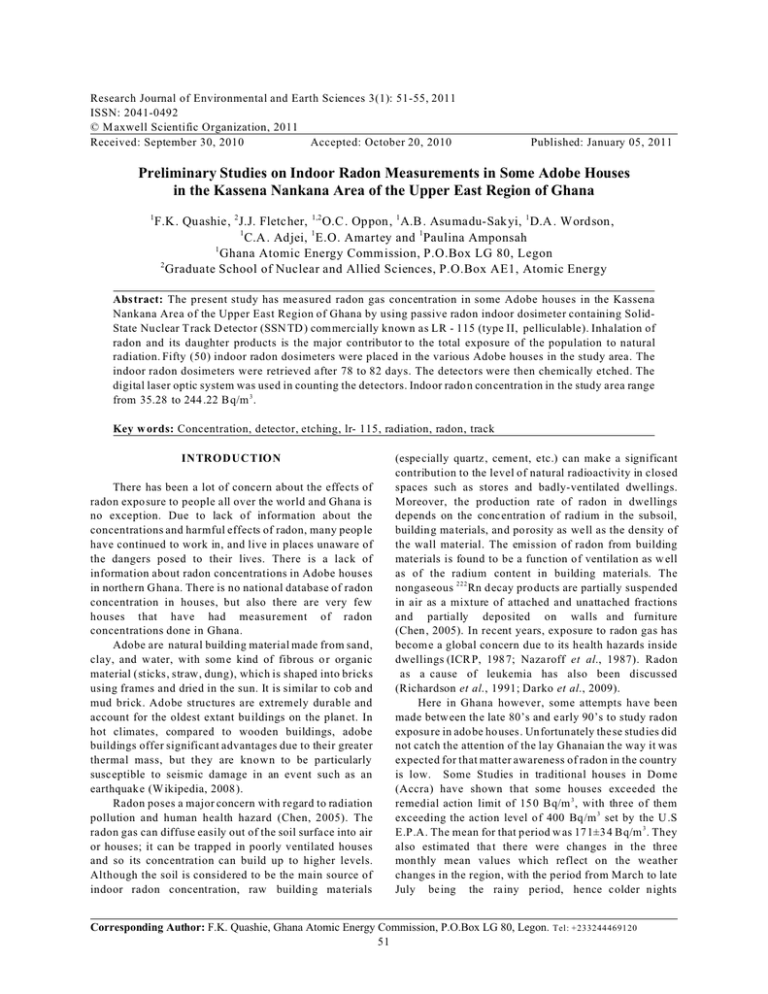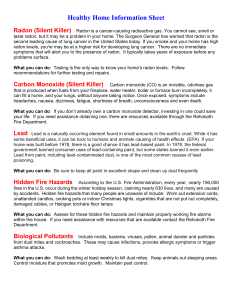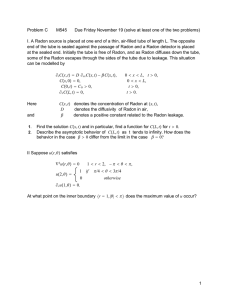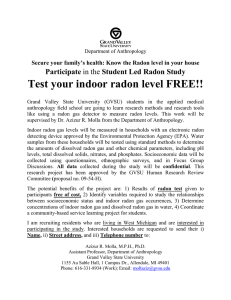Research Journal of Environmental and Earth Sciences 3(1): 51-55, 2011
advertisement

Research Journal of Environmental and Earth Sciences 3(1): 51-55, 2011 ISSN: 2041-0492 © M axwell Scientific Organization, 2011 Received: September 30, 2010 Accepted: October 20, 2010 Published: January 05, 2011 Preliminary Studies on Indoor Radon Measurements in Some Adobe Houses in the Kassena Nankana Area of the Upper East Region of Ghana 1 F.K. Quashie, 2 J.J. Fletcher, 1,2 O.C . Oppon , 1 A.B . Asumadu-Sakyi, 1 D.A . Wordson, 1 C.A . Adjei, 1 E.O. Amartey and 1 Paulina Amponsah 1 Ghana Atomic Energy Comm ission, P.O.Box LG 80, Legon 2 Graduate School of Nuclear and Allied Sciences, P.O.Box AE1, Atomic Energy Abstract: The present study has me asured radon gas concentration in some Adobe houses in the Kassena Nankana Area of the Upper East Region of Ghana by using passive radon indoor dosimeter containing SolidState Nuclear T rack D etector (SSN TD ) com merc ially known as LR - 115 (type II, pelliculable). Inhalation of radon and its daughter products is the major contributor to the total exposure of the population to natural radiation. Fifty (50) indoor radon dosimeters were placed in the various Adobe houses in the study area. The indoor radon dosimeters were retrieved after 78 to 82 days. The detectors were then chemically etched. The digital laser optic system was used in counting the detectors. Indoor rado n con centration in the study area range from 35.28 to 244 .22 B q/m 3 . Key w ords: Concentration, detector, etching, lr- 115, radiation, radon, track INTRODUCTION There has been a lot of concern about the effects of radon expo sure to people all over the world and Ghana is no exception. Due to lack of information about the concentrations and harmful effects of radon, many peop le have continued to work in, and live in places unaware of the dangers posed to their lives. There is a lack of information about radon concentrations in Adobe houses in northe rn Ghana. There is no national database of radon concentration in houses, but also there are very few houses that have had measurement of radon concentrations done in Ghana. Adobe are natural building material made from sand, clay, and w ater, with some kind of fibrous o r organic material (sticks, straw, dung), which is shaped into bricks using frames and dried in the sun. It is similar to cob and mud brick. Adobe structures are extremely durable and account for the oldest extant bu ildings on the plan et. In hot climates, compared to wooden buildings, adobe buildings offer significant advantages due to their greater thermal mass, but they are known to be particularly susceptible to seismic damage in an event such as an earthquak e (W ikipedia, 2008 ). Radon poses a major concern with regard to radiation pollution and human health hazard (Chen, 2005). The radon gas can diffuse easily out of the soil surface into air or houses; it can be trapped in poorly ventilated houses and so its concentration can build up to higher levels. Although the soil is considered to be the main source of indoor radon concentration, raw building ma terials (especially quartz, ceme nt, etc.) can make a significant contribution to the level of natural radioactivity in closed spaces such as stores and badly-ventilated dwellings. Moreover, the production rate of radon in dwellings depends on the conc entration of rad ium in the subsoil, building ma terials, and porosity as well as the density of the wall material. The emission of radon from building materials is found to be a func tion of ventilation as w ell as of the radium content in building materials. The nongaseous 2 2 2 Rn decay products are partially suspended in air as a mixture of attached and unattached fractions and partially deposited on walls and furniture (Chen , 2005). In recent years, exposure to radon gas has becom e a global concern due to its health hazards inside dwellings (ICR P, 198 7; Naza roff et al., 1987). Radon as a cause of leukemia has also been discussed (Richardson et al., 1991; Darko et al., 2009). Here in Ghana however, some attempts have been made betw een the late 80’s and early 90’s to study radon exposu re in adobe ho uses. Unfortunately the se stud ies did not catch the attention of the lay Ghanaian the way it was expected for that matter awareness of radon in the country is low. Some Studies in traditional houses in Dome (Accra) have shown that some houses exceeded the remedial action limit of 15 0 Bq/m 3 , with three of them exceeding the action level of 400 Bq/m 3 set by the U .S E.P.A. The mean for that period w as 171±34 Bq/m 3 . They also estimated that there were changes in the three mon thly mean values which reflect on the weather changes in the region, with the period from March to late July be ing the rainy period, hence colder nights Corresponding Author: F.K. Quashie, Ghana Atomic Energy Commission, P.O.Box LG 80, Legon. 51 Tel: +233244469120 Res. J. Environ. Earth Sci., 3(1): 51-55, 2011 and a significant increase in the radon levels (Oppon et al., 1990). The objective of this study is to provide some data on the indoor radon concentrations in Adobe houses in the northern parts of Ghana MATERIALS AND METHODS The study was performed at the Physics Department of the National Nuclear Research Institute, G hana Atomic Energy Commission from Septem ber - Decembe r, 2008. Description of study area: The Kassena Nankana Area of the U ER of Ghana lies between latitudes 10º30! and 11º00! N of the equator, between longitudes 1º00! and 1º30! west of the zero meridian and covers an area of 1,675 km 2 along the G hana-B urkina Faso border. It measures roughly 50 km long and 55 km wide and has an altitude of 200 -400 m above sea level. The land is relatively flat and passin g throu gh it from B urkina Faso is the White Volta River, which feeds Lake Volta (the world’s largest artificial lake) in the Volta region, south of Ghana. Located in the Guinea Savannah be lt, the district’s ecology is typically Sahelian (hot and dry), with the vegetation consisting mostly of semi-arid grassland interspersed with short trees. There are tw o ma in clima tic seasons, the wet and dry seasons. The wet season extends from April to Octo ber, w ith the heaviest rainfall main ly occurring between June and October (Nyarko et al., 1999). The geolo gy in the study area mainly consists of Birimian rocks of the Pre-Cambrian age and granitoids (granodiorites, granite and g neiss). The Birimian rocks are associated with the granites, while the granites intruded into the Birim ian meta-sediments during a period of orogeny. The Birimian meta-sediments are made up of phyllite, schist and quartzite and ca n be fo und in sma ll patches among the granitoids. The granite complex has developed secondary permeability and porosity as a result of fracturing and weathering of the material. The upper layer is presently covered with alluvial material. The Ghanaian Soil Research Institute (SRI) distinguishes three soil types in the alluvial material in the UER (Berg, 200 8). The Kassena Nankana Area is predomin antly rural in outlook, the population of the area from the 2000 Population and Housing C ensus is estimated to be 149,680. The figure represents 1.0% increase over the 1984 figure of 149,491. This inter censual growth rate of 1% is below the national growth rate of 2.7% Most of the entire District’s population live in rural settlements (Ghana District Assemblies, 2008). Kassena Nankana Central District Assembly and Kassena N ankana East District Assembly with Navrongo and Paga as the district capitals respectively are the two districts in the study area. Fig. 1: A typical Adobe house found in the study area Fig. 2: A picture showing how the detector was deployed in one of the rooms The study area can also boast of two constituencies nam ely Navrongo C entral and C hiana-Paga. One of the types of Ad obe houses in the study area is show n in Fig. 1. Indoor radon gas m easurement: A wide variety of wellestablished techniques are available for the measurement of radon, and their progeny levels either by active or passive method s (Da nalak shmi et al., 2008). Sampling included Adobe constructed houses which are built with locally manufactured materials, these Adobe constructed houses have poor ventilation due to it’s small windows, which are used and sometimes not at all. This samp ling w as homog eneo us in that the detectors were randomly placed in the homes at corners of the rooms away from the openings. This was to give an indication of the exposure lev el of the entire are a. In all about fifty houses will be considered. The Bare detector method or envelope type radon mon itor was used. It consists of a bare LR115 detector film placed in an envelop e with one half exposed and the other half protected to be used as the background. The 52 Res. J. Environ. Earth Sci., 3(1): 51-55, 2011 Tab le 1: 222 Rn concentrations and their averages for indoor measurements in some parts of the Kassena Nankana Area conc. Up per conc. conc. co nc . Biu (Bq /m 3 ) Gaane (Bq /m 3 ) Vonania (Bq /m 3 ) Bu ndu nia (Bq /m 3 ) ----------------------------------------------------------------------------------------------------------SGX 02 147.79 SAG 73 244.22 SAB 66 194.40 SGU 55 84.08 SHH 23 93.66 SAG 70 141.12 SAE 11 115.98 SGN 50 62.83 SGL 68 134.48 SAH 45 48.75 SAB 18 44.65 SAB 84 67.79 SHH 27 226.39 SAG 62 151.87 SAB 82 137.00 SGN 71 170.98 SHG 21 157.49 SAG 79 226.93 Average 151.96 162.58 123.01 96.42 Co nc . Co nc . Kaakung Conc. Ma mprusi Conc. 3 3 3 Chiana (Bq /m ) Kay oro (Bq /m ) Paga (Bq /m ) Co mm unity (Bq /m 3 ) ----------------------------------------------------------------------------------------------------------------WB C 38 46.77 01 152.78 NGE 48 81.26 NGC 35 101.10 WB C 18 120.07 02 144.84 NGE 61 94.38 NGA 41 85.07 WB C 61 110.40 03 201.14 NGE 23 159.91 NGA 11 111.61 WBC 8 176.03 04 166.57 NGE 18 173.36 NGA 62 69.20 WB C 43 191.80 05 223.69 Average 129.01 177.80 122.00 91.74 detector was of dimension 6.0 cm x 4.2 cm.The detectors were then deplo yed by placing them in the corners of the various rooms and held in position by tag pins as is shown in Fig. 2 in one of the house s monitored . Sampling was done at random depending on who perm its us to ca rry out the study in his or her h ouse . In all fifty (50) roo ms w ere monitore d. These detectors w ere kept in the rooms for periods betw een seventy eight (78) eight four (84) days before being removed. The de tectors were then taken to the Nuclear Track Detection Laboratory of the NNR I (GAEC ) for analysis. The detectors w ere then che mically etche d in 2.5 M NaOH solutions for 90 m in at 60ºC and then wash ed very well and dried. The Digital Laser Imaging System of the Laser and F ibre Optics Centre (LFOC ), Department of Physics, University of Cape Coast was used in counting the alpha tracks. conc. Gognia (Bq /m 3 ) ------------------------------SGU 4 121.59 SGN 73 164.61 SGN 77 76.32 SGU 5 148.56 127.77 Conc. Na nia (Bq /m 3 ) ------------------------------NGE 29 35.28 NGD 52 137.47 NGD 32 115.38 NGD 38 163.82 NGE 39 14 7.7 119.93 Fig. 3: Mean indoor radon concentration for the Ten (10) communities in the study area Evaluation of track density: The following parameters are needed in order to obtain the radon concentration for both soil and the indoor measurements: Track density (D) Calibration factor (,) Time of exposure in hours T (h) Track density was evaluated by the formula: Track density (D) = Average number of tracks obtained /Area of count (1) Fig. 4: A histogram showing the frequency concentration for the indoor measurements Radon Concen tration in B q/m 3 and K B q/m 3 for indoor and soil measuremen ts respectively w ere evaluated using the formula: , T(h) and Rn = The calibration factor = The expo sure time in hours. RESULTS AND DISCUSSION 3 Concen tration (K Bq/m ) = D – D B / , T (h) (2) Table 1 shows the Radon con centrations an d their averages for indoor me asurements in forty five (45) rooms in the study area. Figure 3 and 4 shows the mean in door radon concentrations of the ten communities in the study where, D = Th e track density DB = Th e Ba ckground track density 53 Res. J. Environ. Earth Sci., 3(1): 51-55, 2011 Bq/m 3 action levels. From the statistical error on track counting the statistical uncertainty of the trac k den sity was about ten percent (10 %) area and the frequency distribution of the indoor radon concentration in the study area respectively. The measurements were done in fifty (50) Adobe houses but data is presented for only forty five (45) mea surem ents. Five (5) of the detectors w ere lost. The results should be taken as an initial data, an d to find out the range of rado n con centrations in the different types of Adobe houses in the study a rea. Th e results indicate where we can expect high levels of radon concentrations. The radon concentrations in the study range between 35.3 and 244.2 Bq/m 3 . Concentrations above the Action Level of 150 Bq/m 3 set out by the US EPA were found in 38% of the Adobe houses in the study area. The mean concentration of the ten (10) communities is shown in Fig. 3 with their concentrations ranging from 91.74_ 177.80 B q/m 3 . Here it is striking to note that a community like Upper Gaane had one of its houses registering (house number SAG 73) the highest concentration of 24 4.2 Bq/m 3 with the Kayoro com mun ity having the highest mean concentration of 177.8 Bq/m 3 . The frequency distribution of indoor radon levels is show n in Fig 4. This distribution of indoor radon concentrations is normal and it is a departure from the log- normal distribution found in most works of this nature (Owusu., 1989; Hadad et al., 2007; Lianqing et al., 1987). The distribution pattern of this work can be attributed to the same nature of housing types monitored in the study area. These are some probable explanations for the higher levels of 2 2 2 Rn in 38% of the Adobe houses under consideration: C C C CONCLUSION The main objectives of the study are to prov ide data on the indoor radon concentrations in Adobe houses in the northern of parts Ghana and to determine the correlation between the indoor radon concentration and that of the soil. The determination of the indoor radon concentration in some selected households and the determination of the soil radon concentration around some of the selected households are ways to achieve the said objectives. The overall average indoor radon concentration of the ten communities monitored using the SSNTD technique was 130.03 B q/m 3 . This value is below the radon reference level which ranges from 200 _ 600 Bq/m 3 as recommended by ICRP, IAEA (50), and is lower than the US A interven tion radon lev el of 150 Bq/m 3 . All these not withstanding 38% of adobe house s in the study are had high indoor radon concentration values. Construction materials, poor ventilation, age of building and life styles of inhab itants/occupants are the main possible reasons for those high concentration obtained. The freque nt occurrence of high levels of rad on in this and the limited surveys show how w idespread radon is. ACKNOWLEDGMENT The authors are ve ry grateful to the National Nuclear Research Institute of the Ghana Atomic Energy Commission, the Graduate school of Nuclear and Allied Sciences of the University of Ghana and Laser and Fibre Optics Centre (LFO C), Department of Physics, Un iversity of Cape Coast for the use of their facilities for the study. The type of construction materials used for the building and the way it was built gives rise to ventilation challenges. Most of the windows of the Adobe houses in the study area are not open ed at all which leads to a relatively low level of fresh air in the buildings All the houses in the study area monitored had no platform (sub-floor) on which the super structure is placed. For this reason, a direct coupling is created between the building and the soil which leads to direct radon emissions into the buildings Life styles of inh abitants/occu pants REFERENCES Berg, J.V.D., 2008. Exploring shallow groundwater irrigation: Current status and fu ture application . A case study in the Atankwidi catchment, Ghana, M.Sc. Thesis, Delft University of Technology. Chen, J., 2005. A Review of Radon Doses. Radiation Protection Bureau, Health Canada Radiation Protection M anagem ent, 22(4). Danalak shmi, B., S. Balasundar and K.R. Sreedevi, 2008. Radon measurements in the residential colony of Nuclear Power Station at Kalpakkam using track detectors. Radiat. Meas., 43: S456-S458. Darko, E.O., O.K. Adukpo, J.J. Fletcher, A.R. Awudu and F. Otoo, 20 09. Preliminary studies on Radon 222 Concentration in ground water from selected areas of the Accra Metropolis in Ghana. J. Radioan al. Nucl. Chem., 282(2): 507-517. The results of this work compared with work done by Oppon et al. (1990) in similar housing type shows some resemblance (i.e., In his work an average percentage of twenty eight (28%) of the houses monitored exceeded the action level of 150 Bq/m 3 for the three surveys’ done within a nine (9) mo nth period. It is also intriguing to note that for the same said work, the results showed that about 44% of the houses monitored during the first period, 27% during the sec ond and 13% during the third perio d respectively had radon concentrations exceeding the 150 54 Res. J. Environ. Earth Sci., 3(1): 51-55, 2011 Ghana District Assemblies, 2008. Retrieved from: www .ghanadistrictassemblies.com, (Access on: Septem ber 15, 200 8). Hadad, K., R. Doulatdar and S. Mehdizadeh, 2007. Indoor radon monitoring in Northern Iran using passive and active measurements. J. Environ. Radioact., 9: 539-552. ICRP, 1987. Lung C ancer Risk from indoor Exposure to Radon Daughters, Publication 50, Annals of ICRP, Pergam on Press, N ew Y ork, 17 (1). Lianqing, L., C. Zhipeng, L. Guiyuan and C. Amin, 1987. Indoor radon measurements in the region of Beijing, People’s Repu blic of China. Health Ph ys., 53(3): 219-225. Nazaroff, W .W ., S.M. Doyle, A.V. Nero and R.G. Sexto, 1987. Portable water as a source of airborne Rn-222 in us dwellings: A review and assessment. Health Phys., 52(3): 281-296. Nyarko, P., P. Wontuo, A. Nazzar, J. Phillips, P. Ngom and F. Bin ka, 19 99. N avrongo Demog raphic Survey System. Report to the Rockefeller foundation, Docum entation Note N umb er 41. Oppon, O.C ., H.M . Aniagye and A.W.K. Kyere, 1990. Monitoring of natural background radiation in some Ghanaian homes. International conference on high levels of natural radiation, 3rd-7th November, 1990. RAM SAR, Islamic Republic of Iran. Owusu, K.R ., 1989. Indoor Radon m onitoring in Kumasi using Solid State Nuclear Track Detection Technique, B.Sc. project work, University of Science and Technology, Ghana Richardson, R.B ., J.P. Eatough and D.L. Hensshaw, 1991. Dose to red bone marrow from natural radon and thoron exposure. Br. J. Radiol., 64(763): 608-624. W ikipedia, 2008. Retrieved from: http://en.W ikipedia. org/wiki/A dobe, (A ccess on : July 21, 2008 ). 55




